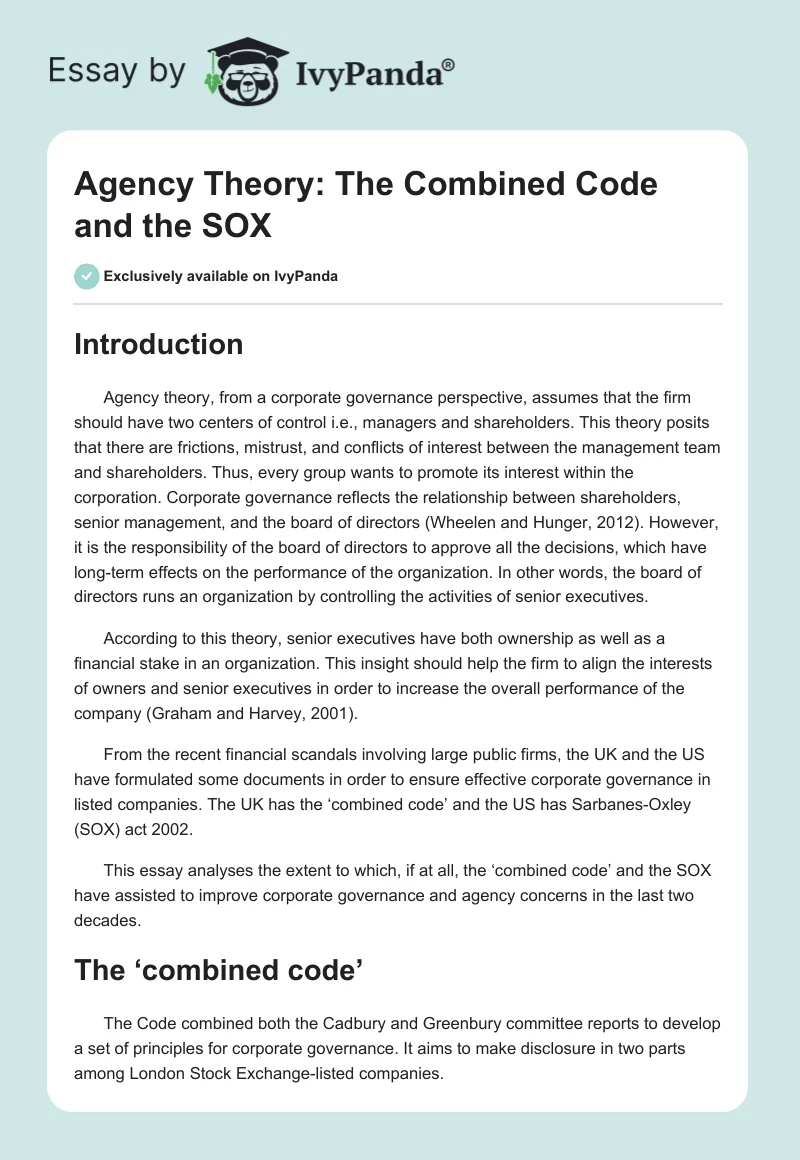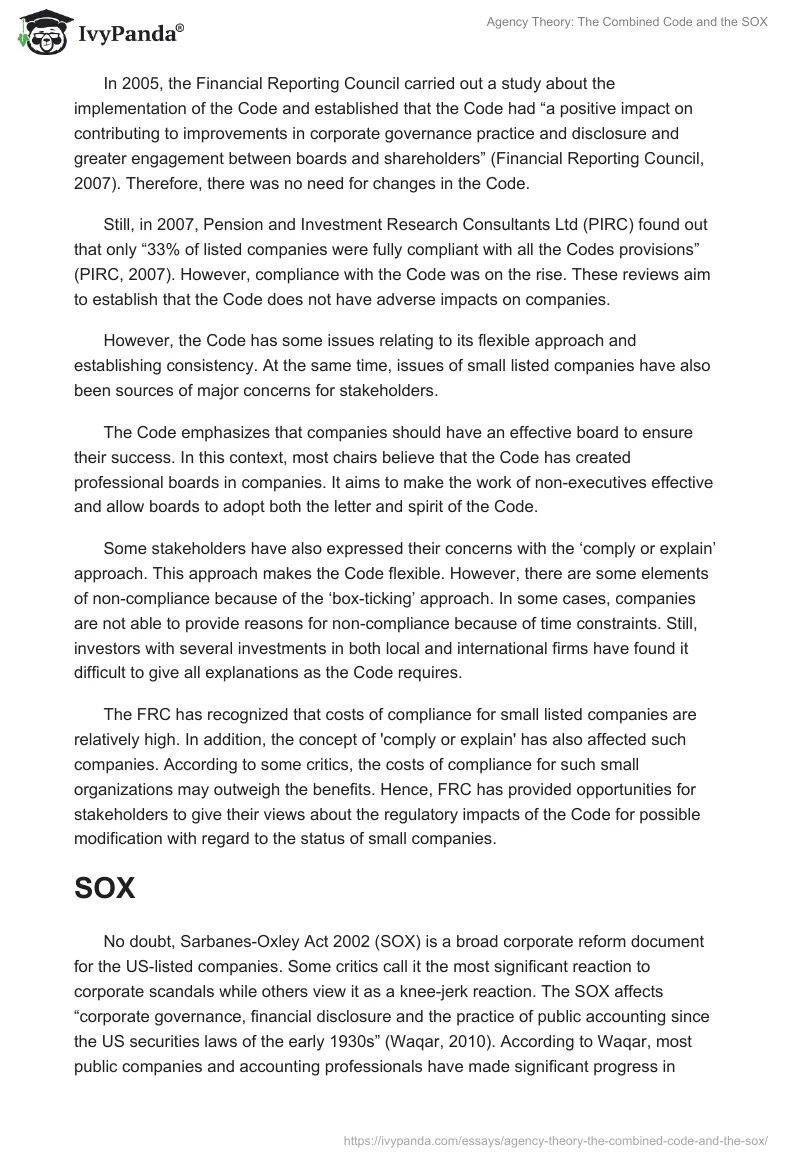Introduction
Agency theory, from a corporate governance perspective, assumes that the firm should have two centers of control i.e., managers and shareholders. This theory posits that there are frictions, mistrust, and conflicts of interest between the management team and shareholders. Thus, every group wants to promote its interest within the corporation. Corporate governance reflects the relationship between shareholders, senior management, and the board of directors (Wheelen and Hunger, 2012). However, it is the responsibility of the board of directors to approve all the decisions, which have long-term effects on the performance of the organization. In other words, the board of directors runs an organization by controlling the activities of senior executives.
According to this theory, senior executives have both ownership as well as a financial stake in an organization. This insight should help the firm to align the interests of owners and senior executives in order to increase the overall performance of the company (Graham and Harvey, 2001).
From the recent financial scandals involving large public firms, the UK and the US have formulated some documents in order to ensure effective corporate governance in listed companies. The UK has the ‘combined code’ and the US has Sarbanes-Oxley (SOX) act 2002.
This essay analyses the extent to which, if at all, the ‘combined code’ and the SOX have assisted to improve corporate governance and agency concerns in the last two decades.
The ‘combined code’
The Code combined both the Cadbury and Greenbury committee reports to develop a set of principles for corporate governance. It aims to make disclosure in two parts among London Stock Exchange-listed companies.
In 2005, the Financial Reporting Council carried out a study about the implementation of the Code and established that the Code had “a positive impact on contributing to improvements in corporate governance practice and disclosure and greater engagement between boards and shareholders” (Financial Reporting Council, 2007). Therefore, there was no need for changes in the Code.
Still, in 2007, Pension and Investment Research Consultants Ltd (PIRC) found out that only “33% of listed companies were fully compliant with all the Codes provisions” (PIRC, 2007). However, compliance with the Code was on the rise. These reviews aim to establish that the Code does not have adverse impacts on companies.
However, the Code has some issues relating to its flexible approach and establishing consistency. At the same time, issues of small listed companies have also been sources of major concerns for stakeholders.
The Code emphasizes that companies should have an effective board to ensure their success. In this context, most chairs believe that the Code has created professional boards in companies. It aims to make the work of non-executives effective and allow boards to adopt both the letter and spirit of the Code.
Some stakeholders have also expressed their concerns with the ‘comply or explain’ approach. This approach makes the Code flexible. However, there are some elements of non-compliance because of the ‘box-ticking’ approach. In some cases, companies are not able to provide reasons for non-compliance because of time constraints. Still, investors with several investments in both local and international firms have found it difficult to give all explanations as the Code requires.
The FRC has recognized that costs of compliance for small listed companies are relatively high. In addition, the concept of ‘comply or explain’ has also affected such companies. According to some critics, the costs of compliance for such small organizations may outweigh the benefits. Hence, FRC has provided opportunities for stakeholders to give their views about the regulatory impacts of the Code for possible modification with regard to the status of small companies.
SOX
No doubt, Sarbanes-Oxley Act 2002 (SOX) is a broad corporate reform document for the US-listed companies. Some critics call it the most significant reaction to corporate scandals while others view it as a knee-jerk reaction. The SOX affects “corporate governance, financial disclosure and the practice of public accounting since the US securities laws of the early 1930s” (Waqar, 2010). According to Waqar, most public companies and accounting professionals have made significant progress in compliance with the SOX. The Act protects whistleblowers, prohibits granting of loans to executives, and requires all audit committees to be independent. In addition, such committees do not get any fees other than the required fees of directors. Still, the CFO and CEO must certify all financial data of the company. According to the Act, the same auditor cannot provide both internal and external audit functions to the same firm (Sarbanes Oxley, 2012).
Some critics view the Act as an extra burden on foreign companies in the US exchange. They claim that some of the issues are not of interest to foreign companies, or such companies have already addressed them. Conversely, Bostelman argues that not all provisions are burdens to foreign companies (Waqar, 2010). However, the main controversial issue is the provision that requires independent audit committees in listed companies. Most foreign companies believe that the provision “indirectly strengthens labor’s bargaining power by giving labor representatives on the audit committee substantive responsibilities and gaining access to susceptible information” (Waqar, 2010). The Act requires labor representatives to have substantial roles in the committee. This is because the committee must consist of members of the labor unions and supervisory committee.
However, SEC tried to eliminate this problem by allowing foreign employee representatives to be members of the audit committee.
Initially, costs of compliance with the Act for large companies were high. However, this has dropped over the years as companies have consolidated their accounting practices for efficient practices. Companies that have consolidated their accounts receivable into one have recorded substantial savings. There are also additional benefits from increased disclosure and reliable corporate financial statements.
Firms no longer report figures with excessive adjustments. This was a common practice in the past where firms used such strategies to boost their earnings. In addition, executives cannot postdate their stock options. Wheelen and Hunger note that the Act has affected other companies around the world.
To improve corporate governance, some institutions have focused on the implementation of requirements of the Act. For instance, SEC requires that firms, which have implemented the Act, declare whether they have also adopted codes of ethics that apply to CEOs and CFOs. In addition to other requirements, SEC also wants organizations to have external directors in areas of audit, compensation and nominating committees. The New York Stock Exchange has reinforced the Act by insisting on outside directors in nominating and governance committees. Finally, NASDAQ also requires that most independent outside directors or a nominating committee of independent outsiders should nominate new directors.
Clearly, there were systemic weaknesses in the corporate governance practices before the introduction of the ‘combined code’ and the SOX. However, corporate governance should go beyond just correcting the obvious elements of past scandals. Ineffective corporate governance practices resulted from offenses and laxity of the board of directors and executives.
Both the Code and SOX cannot be sufficient in protecting the welfare of shareholders in listed companies. Thus, accountability is the only solution for investors. In this respect, these Acts provide opportunities for stockholders to seek accountability from nonperforming committees and individuals like managers, auditors, directors, and other participants (Ross, Westerfield, and Jordan, 2008). This is because their actions have direct impacts on the shareholder’s returns. Thus, it is imperative for the Acts to reinforce the importance of corporate governance and excellent performance by managers and directors. In this sense, they must implement the Acts in both letter and spirit.
Conclusion
Agency theory relates to corporate governance due to cases of conflicts between top management and shareholders of an organization. The theory puts it that managers may only engage in activities, which promote their interests and not the interests of the organization. The theory proposes several solutions to dealing with such conflicts from costs and risk-sharing. These solutions aim to align the interests of both shareholders and managers with those of the organization (Arnold, 2007). Effective corporate governance in an organization ensures that a firm does not fail due to agency problems.
Generally, both the Code and SOX have attained remarkable impacts in providing an effective corporate governance environment. However, these Acts face various challenges during implementation. For instance, the Code must review its approaches of ‘box-ticking’ and ‘explain or comply’ for small organizations and overseas and multiple investments. On the other hand, SOX must address the issue of foreign listed companies and the compositions of various committees. Shareholders must bear the costs of compliance with these Acts, which are small fractions relative to losses they incur due to ineffective corporate governance.
Reference List
Arnold, G 2007, Essentials of corporate financial management, Pearson Education Limited, Harlow, Essex.
Financial Reporting Council 2007, Review of the Impact of the Combined Code, FRC, London.
Graham, J, and Harvey, G 2001, ‘The theory and practice of corporate finance: evidence from the field’, Journal of Financial Economics, vol. 60, no. 2-3, pp. 187-243.
PIRC 2007, Review of the Impact of the Code, PIRC, London.
Ross, S, Westerfield, W and Jordan,D 2008, Essentials of corporate finance, 6th edn, McGraw-Hill/Irwin, New York.
Sarbanes Oxley 2012, Sarbanes Oxley: A Brief Overview. Web.
Waqar, A 2010, Impact of Sarbenes-Oxley Act. Web.
Wheelen, T and Hunger, D 2012, Strategic management and business policy: toward global sustainability, 13th edn, Pearson Education, New York.


